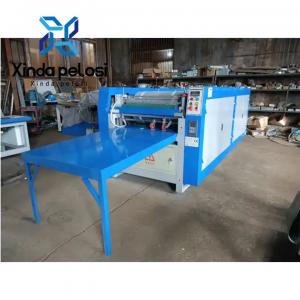

Add to Cart
Model | XDP-YSJ1 | XDP-YSJ2 | XDP-YSJ3 | XDP-YSJ4 | XDP-YSJ5 |
Printing color | 1color | 2colors | 3colors | 4colors | 5colors |
Power | 0.75kw | 1.5kw | 1.5kw | 2.2kw | 3kw |
Maximum entering machine width | 840mm | ||||
Maximum printing width | 650mm | ||||
Rubber relief printing thickness | 4-6mm | ||||
Maximum printing length | 1200mm | ||||
Printing roller diameter | 420mm | ||||
Printing speed | 1500-4000pcs/h | ||||
Gross weight(approximately) | 500KG | 800KG | 1100kg | 1500kg | 1800kg |
Installs the size | 900*1350*1150mm | 1400*1350*1150mm | 2000*1350*1150mm | 2500*1350*1150mm | 3000*1350*1150mm |
Design Preparation: Before printing, prepare the design artwork using graphic design software. Ensure that the design is correctly sized and formatted to fit the paper bags.
Machine Setup: Set up the digital printing machine according to the specifications of the paper bags being used. This includes adjusting parameters such as print resolution, color profiles, and substrate thickness.
Material Loading: Load the paper bags onto the printing machine's feeding mechanism. Ensure that the bags are properly aligned and securely held in place to prevent misprints or jams.
Printing Process: Initiate the printing process through the machine's control panel or software interface. Monitor the printing progress to ensure that the design is accurately applied to each paper bag.
Quality Control: Regularly inspect the printed paper bags for quality assurance. Check for any printing defects, color inconsistencies, or alignment issues that may affect the final product.
Drying/Curing: Depending on the printing technology used (e.g., inkjet or electrophotographic), the printed paper bags may require drying or curing to ensure that the ink adheres properly and does not smudge.
Finishing Touches: After printing, the paper bags may undergo additional finishing processes such as folding, creasing, or laminating, depending on the desired final product.
Packaging and Distribution: Once printed and finished, the paper bags are ready for packaging and distribution. Ensure that the bags are properly stacked and packed to prevent damage during transportation.
1.What factors influence the price of a Digital Pouch Printing Machine?
Factors such as printing technology (e.g., inkjet or electrophotographic), print quality and speed, size and capacity, additional features, brand reputation, and ongoing operational costs can all influence the price of a machine.
2.How does printing technology affect the price?
Machines utilizing inkjet technology may have different pricing structures compared to those using electrophotographic printing. Inkjet printers are often more affordable but may have higher ongoing ink costs, while electrophotographic printers may have higher upfront costs but lower ongoing consumable expenses.
3.What role does print quality and speed play in pricing?
Machines capable of higher print resolutions and faster printing speeds may come at a premium price due to their enhanced performance capabilities.
4.Are there additional features that can impact the price?
Yes, machines equipped with advanced features such as variable data printing, inline finishing options, and automation capabilities may have higher price points.
5.Does brand reputation matter when considering price?
Established brands with a reputation for quality and reliability may offer machines at higher price points compared to lesser-known or generic brands.
6.How can I determine the cost-effectiveness of different machine options?
It's essential to consider the specific needs and requirements of your printing operation when evaluating the cost-effectiveness of different machine options. Assess factors such as upfront costs, ongoing operational expenses, expected print volume, and desired features to make an informed decision.
